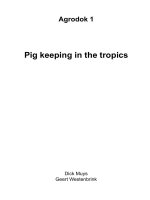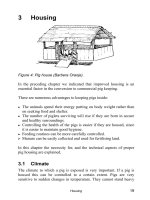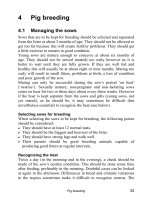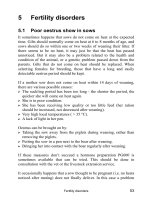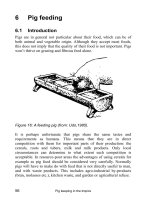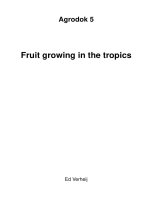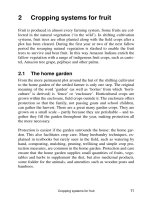Fruit growing in the tropics - Part 3 docx
Bạn đang xem bản rút gọn của tài liệu. Xem và tải ngay bản đầy đủ của tài liệu tại đây (381.22 KB, 20 trang )
Form and function
15
3 Form and function
3.1 Single-stemmed and branched fruit crops
There are a few fruit crops that come to the fore wherever the growing
conditions permit their cultivation: papaya, coconut, pineapple and
banana. The growth habit of all these plants resembles a single, giant
shoot. That is why we call them single-stemmed plants (although,
strictly speaking, this is not correct – see Box). This shoot grows con-
tinuously, the growing point at the shoot tip forming leaves and inflo-
rescences in orderly succession.
Papaya and coconut form flowers in the axil of every leaf, pineapple
and banana flower at the shoot tip after sufficient leaves have been
produced to sustain fruit growth.
The form of these single-stemmed crops implies that if they grow
faster they will also flower and fruit sooner. Moreover, leaves and fruit
grow to a larger size when growing conditions are favourable. For the
grower these are relatively simple crops, because they respond well to
crop care (watering, manuring, crop protection). If only you make sure
that the plants grow well they will produce high and predictable
yields. Because the growing point is always active, fruit can be har-
vested at any time of the year. So it is not surprising that these crops
are grown wherever possible; they are important to rich and poor.
Different forms of branching
Banana and pineapple form suckers, which are in fact branches. However,
suckers do not much affect form and functioning of the mother shoot, so here
we just consider both crops (and suckering palms such as date palm and peji-
baye) as single-stemmed plants. You may have seen papaya plants that
through some mishap have formed a few branches. Because each of these
branches resembles the unbranched papaya in form and functioning, we still
include such plants in the single-stemmed category.
Branching of the true branched fruit crops is of a different order. They branch
to adapt their form to the available space (branches grow towards the light).
Vines are the champions in this respect; they have no fixed form at all. The
form of a vine depends on the support it finds in searching for light.
Fruit growing in the tropics
16
Continuous and intermittent growth
The single-stemmed fruit crops are only a small, but extremely impor-
tant, minority. By far most fruit crops are freely branching trees. The
shoots of most of these branched species do not grow continuously but
intermittently. Shoots extend during a flush, rapidly unfolding a num-
ber of leaves. Before long the shoot stops growing, no longer issuing
young leaves and matures into an apparently resting twig.
Single-stemmed crop plants can grow continuously because as soon as
they have a full set of leaves the leaf area remains the same, each new
leaf replacing a withering leaf. Nearly all water and nutrients needed
by a tree are taken up by young roots. That is why roots cannot stop
growing; otherwise there soon would be no young roots anymore. The
fairly constant leaf area of single-stemmed plants can be supplied with
water and nutrients if the roots grow at a steady pace.
The roots of branched trees would have to grow ever faster if the
number of shoots and leaves increases unchecked. This is impossible
and may explain why most branched trees grow intermittently rather
than continuously. During a flush the number of leaves increases so
fast that the root system cannot keep up. After the flush, however,
growth of the roots continues and leaf fall gradually reduces the leaf
area. So after a period of (many) months, the tree is again able to sup-
port a flush. As a result the shoot: root ratio in branched trees is not
steady, but fluctuates. Under favourable growing conditions there may
be a rapid succession of flushes, so that branching becomes quite
complex within a few years, as shown in figure 2.
Which buds will flower?
For the fruit grower the most striking feature of branched fruit crops is
that flowering and fruiting have no well-defined place in the growth
habit, in contrast to the single-stemmed crops.
A papaya or coconut that grows reasonably well flowers in every leaf
axil once the juvenile period is over, but it is impossible to say which
of the hundreds or thousands of twigs on a mango tree are going to
Form and function
17
flower and fruit. The tree may flower profusely in one year and hardly
at all in another. Consequently bearing of branched trees is unpredict-
able and much lower on average than in single-stemmed fruit crops.
Since growth comes first, stimulating growth is unlikely to improve
flowering and fruiting. For instance: watering a mango tree during the
dry season to avoid stress will lead to more flushing at the expense of
flowering. Figure 2 shows the rapid increase in branching of a mango
tree growing in ever-wet conditions; the tree did not flower at all.
Figure 2: Branching of a mango tree in Madagascar over 2½
years from planting. All flushing shoots were measured and re-
corded, but in May 1966 only on two branches. Dots show the end
of the previous flush.
Fruit growing in the tropics
18
Shoots and buds
In this book we use the terms shoot and twig for the young branches. As soon
as the youngest leaves on the shoot have matured, the shoot becomes a twig.
A twig bears only mature leaves (the oldest leaves may already have fallen). A
twig only grows by becoming a thicker branch, but some buds on a twig may
break to produce flowers or new shoots during a later flush.
In fruit growing ‘flower bud’ is often used as opposed to ‘leaf bud’, to indicate
the bud that in due course will break into an inflorescence, bearing one or
more flowers. Here we use the term ‘floral bud’, because In common usage
‘flower bud’ stands for a flower just before it opens.
Stress and seasonal yield
While the grower of single-stemmed fruit crops does his best to make
sure that his crops do not suffer stress, for intermittently growing
branched fruit trees a period of stress is in fact welcome – or neces-
sary. A period of unfavourable weather, like a cold or dry season, stops
shoot growth and gives the twigs time to initiate floral buds. Low
temperature is more effective than drought, as can be shown by com-
paring fruit crops such as citrus, mango and avocado, which grow in
the subtropics as well as in the tropics (see Box).
Citrus, mango and avocado in the tropics and subtropics
For all three crops, a rule of thumb is that in the tropics the trees grow twice
as fast and yield only half as much as in the subtropics. In the tropics the dry
season often does not check shoot growth effectively, resulting in large trees
and insufficient twig rest to ensure good flowering and fruiting. In the subtrop-
ics, winter does stop shoot growth; moreover it stimulates formation of floral
buds, resulting in small, profusely flowering trees. But in the subtropics in-
clement springtime weather often leads to poor fruit set. And if fruit sets well
this may lead to overbearing and shortage of shoots that flower next year, re-
sulting in biennial bearing.
Thus, although the crops are the same, the problems faced by the grower are
quite different; in several respect they are quite the opposite. Think twice be-
fore you adopt recommendations based on experience in the subtropics!
Seasonal stress imposed by climate and soil conditions results in si-
multaneous flowering of all trees of a crop (or cultivar). Consequently
the fruit of most branched trees has a short market supply season,
Form and function
19
whereas the fruits of single-stemmed plants are available throughout
the year.
The striking differences between single-stemmed and branched fruit
crops in fruiting and in the required crop care are summarised in Table
1. In the following Sections we shall discuss each of these groups in
more detail, also considering differences within each group.
Table 1: Comparison of single-stemmed and branched fruit crops
Single stemmed crops:
e.g. banana, papaya, coconut
Branched crops:
e.g. mandarin, guava, mango
Growth continuous Growth intermittent
Shoot : root stable Shoot : root fluctuates
Yield - high Yield - low
- predictable - erratic
- year-round - seasonal
Improved growing conditions raise fruiting
more than growth.
Improved growing conditions generally
stimulate shoot growth at the expense of
flowering/fruiting.
Advice: stimulate growth, minimise stress Advice: use seasonal stress to BALANCE
shoot growth with flowering/fruiting
3.2 A closer look at single-stemmed fruit crops
The four single-stemmed fruit crops mentioned before, fall into two
groups: papaya and coconut produce flowers in the axil of every leaf;
banana and pineapple flower at the shoot tip. Growth and flower-
ing/fruiting are closely linked in all these plants: if they are growing
well the yield will be high. Under adverse conditions however, impor-
tant differences between the two groups come to light.
Flowering in the leaf axils
Papaya and coconut have to keep up a steady rate of growth to be able
to produce flowers and fruits in every leaf axil. If growing conditions
deteriorate, for instance during a cold or dry season, growth goes on as
best it can at the expense of flowering and fruiting. In other words:
under stressful conditions flowering and fruiting are sacrificed for the
Fruit growing in the tropics
20
sake of the tree. Therefore these crops require favourable growing
conditions throughout the year; they are confined to the tropics.
If you look at the trunk of a papaya tree you see the scars of the leaves
that have fallen. The small leaves formed during an adverse season
leave small scars close together, quite distinct from the large, well-
spaced scars of leaves formed during a favourable growing season. If
the papaya is a few years old you can read its life history, its periods
of happiness and stress, from the leaf scars on the stem, as shown in
figure 3. The form reflects the way in which the tree functions.
Thus the first task of the
papaya grower is to reduce
stress to a minimum, for
instance by watering during
the dry season, by planting
the trees on a ridge if the
soil is poorly drained, or by
providing shelter on a wind-
swept plain.
In an orchard spacing of the
plants is important. If papa-
yas or coconuts are planted
close together the leaves
cannot spread out freely and
are forced in a more upright
position. The resulting nar-
row leaf axils hinder the
development of flowers and
fruits. Lack of space, like a
period of stress, sets back
flowering and fruiting much
more than vegetative
growth. Coconut palms are often spaced so far apart that they can be
intercropped, because nut production drops sharply if the palms are
Figure 3: Leaf scars on a papaya
trunk
Form and function
21
planted too close together. Hence these species are designed for unre-
stricted growth, both with respect to time and space.
Flowering at the shoot tip
If a banana plant is stressed by drought or cold weather, leaf produc-
tion slows down and, if the stress persists, the new leaves gradually
become smaller. Unlike the papaya, this does not directly affect fruit
yield. The main effect of a period of slower growth is that appearance
of the bunch is delayed: you have to wait longer to harvest the fruit.
Similarly, if you cut a banana leaf now and then to use as an umbrella
or to wrap up your food, you postpone the harvest rather than reducing
it. The same applies to the pineapple, a drought-resistant crop that can
virtually suspend growth in dry conditions.
The leaves of closely spaced bananas or pineapples also assume a
more upright position. The crowding results in a more slender plant
and smaller fruit, but that loss can be made good by the larger number
of plants per ha. The small pineapples preferred in international trade
are produced by reducing the planting distance.
Terminal flowering banana and pineapple adapt much better to ad-
verse conditions than papaya or coconut. The harvest is delayed but
not necessarily reduced by a period of stress. This is why both crops
are also popular in the subtropics; in the tropics they grow up to eleva-
tions of around 1600 m. Flowering at the shoot tip enables these crops
to cope fairly well with stress and crowding.
Other single-stemmed crops
The palms are by far the largest group of single-stemmed perennial
crop plants. Oil palm, pejibaye, arecanut and date palm are examples
of important crops with the same growth habit as coconut. There are
also palms, for instance sago palm, which flower at the shoot tip like
banana; sisal is another example of this growth habit.
Table 2 summarises the main characteristics of the two groups of con-
tinuously growing fruit crops.
Fruit growing in the tropics
22
Table 2: Characteristics of the two groups of single-stemmed fruits
Flowering habit in leaf axils:
growth and flowering com-
bined
at the shoot tip:
flowering after completion of
growth
Examples papaya, coconut pineapple, banana
Response to stress growth continues at the
expense of fruiting
growth slows down and
fruiting is delayed
Adaptation to:
- climate thrive only under minimal
stress
can adapt to drought or cold
- close spacing plants grow taller, yield per
ha declines
plants grow taller, smaller
fruit size, but more fruits per
ha
Conclusion growth habit inflexible;
designed for undisturbed
growth in time and space
growth habit flexible;
fruiting does not suffer much
from seasonal stress or
close spacing
3.3 Form and function of branched fruit trees
Intermittent and continuous growth
The large group of branched fruit trees is very diverse. We have al-
ready seen that branching is commonly associated with intermittent
shoot growth, scanty flowering and seasonal fruiting. That branching
and intermittent growth are closely related is shown by the changes in
the growth habit during the course of the life of branched trees, espe-
cially if grown from seed.
As a rule the seedling grows continuously, but intermittent growth is
seen as soon as the first side shoots are formed. With increasing
branching the interval between flushes tends to become longer and
more twigs generally remain at rest during a flush. From a distance the
tree may seem to be in full flush, but if you look closely you will see
that many twigs are at rest. (These resting twigs may be the ones that
are going to flower!) Trees propagated vegetatively tend to grow in-
termittently from the start, but as branching becomes more complex,
you will notice similar changes in flushing pattern as in trees grown
from seed.
Form and function
23
Some woody plants are able to grow continuously and flower in leaf
axils on the growing shoot, like the single-stemmed papaya. The
clearest examples are vines, such as passionfruits and grape. In their
search for light their shoots grow on and on until – with increasing
branching – growth of the shoots slows down. Breadfruit and coffee
are examples of tree crops showing continuous growth in combination
with flowering in the leaf axils. Jackfruit and durian also have shoots
that tend to grow continuously, but these trees flower on the main
branches and trunk (‘cauliflory’). Whereas intermittently growing
shoots (in flushes), stop growing even under ideal conditions, con-
tinuous shoot growth is brought to a stop by adverse conditions, such
as drought or a load of growing fruits, as in coffee and passionfruit.
In this Section we focus on intermittently growing trees, because the
majority of the fruit crops, including nearly all important ones, belong
to this group. However, continuously growing fruit crops are occa-
sionally mentioned too.
Shoot growth patterns
Growth of the flushing shoot may follow a ‘go – stop’ rhythm, stop-
ping abruptly by abortion of the growing point, as in cocoa and often
in citrus shoots. More often the growing point forms a resting terminal
bud, covered in bud scales, as in mango. In the ‘resting’ bud the grow-
ing point continues to lay down leaf initials, which will unfold when
the bud breaks during the next flush. Flushing can also follow a ‘fast –
slow’ rhythm, growth slowing down to a snail’s pace after the rapid
unfolding of leaves at the start of the flush, until it picks up again in
the next flush (rambutan, nutmeg). In this case the ‘resting’ bud is usu-
ally naked, not covered by bud scales.
Shoot growth is called ‘determinate’ if during a flush only leaves un-
fold that had already been laid down in the bud. If the shoot tip con-
tinues to form new leaves, the flush is prolonged and shoot growth is
said to be ‘indeterminate’. Several fruit crops bear both determinate
shoots (short shoots, called spurs in pomegranate, apple, pear, plum)
and indeterminate shoots (long shoots, called whips in plum and cus-
Fruit growing in the tropics
24
tard apples). Indeterminate shoots may be seen as a step towards con-
tinuously growing shoots. You can observe the various flushing pat-
terns on your own trees.
Fitting flowering/fruiting in with shoot growth
Branched trees have a much more flexible habit of growth than single-
stemmed plants. Unfortunately for the fruit grower, however, this
flexibility is gained at the expense of flowering and fruiting. The natu-
ral function of fruiting is to provide the seeds needed to produce the
next generation. So it is not surprising that branched trees have made
adaptations to ensure seed production as best they can in spite of lib-
eral shoot growth. Two strategies are common: shoot growth and re-
productive growth take place at different times or in different loca-
tions.
Separation in time
Intermittently growing fruit crops use the time between flushes for
floral development: apart from a few exceptions, they lay down floral
buds on the resting twig. Hence, these crops combine flower-
ing/fruiting with free branching by separating the two: shoot growth
and floral development take place at different times.
Floral buds may be formed in leaf axils or at the tip of the resting
twig. As these floral buds break, they may either produce only an in-
florescence, or a flushing shoot with inflorescence(s). Figure 4 depicts
the four possibilities with examples. Note that quite a few fruit crops
flower both in the leaf axils and at the tip, or directly on the twig as
well as on the new shoots.
As shown in figure 4, guava flowers in leaf axils of the flushing shoot.
However, these flowers were already initiated before the bud on the
resting twig flushed. Inside the bud that is about to break you can see
under the microscope the leaf initials which will expand during the
flush, but also the first signs of floral development in axils of these
tiny leaf initials. In other words: the events that lead to flowering on
new shoots commonly start on the resting twig.
Form and function
25
Figure 4: Flowering on twigs and shoots, at the tip and in leaf axils,
with examples. Note that many fruit crops form flowers in more
than one position. *) Flowering only on leafless parts **) Breaking
buds form a rosette of leaves and a cluster of flowers.
Flowering in separate locations
Custard apples, pomegranate, apple, pear and plum all lay down floral
buds on the resting twig; they also have both long (indeterminate) and
short (determinate) shoots. The growth of the short shoots terminates
early, allowing these ‘spurs’ more time to initiate flowers. Although
flowering occurs on long twigs too, flowering and fruit set are much
better on the spurs. Hence these crops combine separation of shoot
growth and floral development in time with preferential flowering in
special locations.
Fruit growing in the tropics
26
Figure 5: Young durian tree with horizontal ‘feathers’ and one vig-
orous upright branch. By cutting that branch you keep the tree
small and foster the growth of more fruitful branches.
Coffee is an example of flowering on special, continuously growing
shoots. Coffee has quite distinct shoot types: one or more upright
shoots (‘orthotropic’ shoots), each with numerous horizontally grow-
ing side shoots (‘plagiotropic’ shoots). Only the plagiotropic shoots
bear flowers. Several fruit crops have a tendency towards plagiotropy,
be it not as extreme as in coffee. Durian, for instance, has mainly hori-
zontal (plagiotropic) branches and usually one or several sturdy up-
right (orthotropic) branches. The distinction between the horizontal
‘feathers’ and upright vigorous branches is quite clear in young trees,
as shown in figure 5. Unlike coffee, both types of branches bear fruit,
but the orthotropic branches mainly contribute to tree size and the pla-
giotropic branches mainly add to the crop.
Form and function
27
Durian has more or less distinct shoot types, but the most striking fea-
ture is that its flowers are formed on the underside of the branches
close to the tree trunk. Flowering on the tree trunk and main branches,
called cauliflory, is a very effective way of allocating shoot growth
and floral development to different locations. It sets shoot growth free:
durian and jackfruit shoots grow more or less continuously, while the
shoots of cocoa grow in frequent flushes.
The above examples of durian, custard apples, etc. show that com-
bined strategies to better separate flower formation and shoot growth
are common. Nevertheless, poor flowering remains the main factor
limiting yield of branched fruit crops. This applies in particular to
crops that lay down floral buds on resting twigs. These crops form a
large and important group. Although the behaviour of these crops is
still poorly understood, an approach towards improved flowering is
outlined in the following paragraphs.
Floral buds on resting twigs
In spite of the fragmentary information it appears that adequate flow-
ering depends largely on two conditions:
? Synchronous flushing
? No flushing shoots before and during the formation of floral buds.
Synchronisation of flowering
Synchronous flushing means that the tree goes through distinct phases
for shoot growth and floral development. If a large proportion of the
twigs produces new shoots simultaneously, these shoots mature at the
same time, becoming resting twigs that in due course should produce a
synchronous flowering flush. Indications are that flowering is more
profuse if not just individual twigs, but the entire tree gets into ‘floral
mode’. Such a concentrated bloom also favours pollination and fruit
set. The resulting clear-cut annual crop cycle greatly facilitates tree
management, as it establishes a proper time for fertilising, pruning,
crop protection treatments, harvesting, etc. (see Chapter 6).
Fruit growing in the tropics
28
Synchronisation results from stress imposed by the environment. Tree
species differ greatly in the severity of stress required to ensure syn-
chronous shoot growth and synchronous flowering. A degree of syn-
chronisation is the rule, even in the humid tropics, where a brief dry
spell or a cooling shower after a few hot days are the main upheavals
in the weather. Some rubber clones even shed their leaves in response
to a change of weather that most people do not notice. Spondias spe-
cies (ambarella, mombin) stand leafless following a brief ‘dry’ spell.
Loss of leaves enables the roots to trigger a synchronous flush, be it a
flowering flush or a flush of shoots. Other fruit crops at home in the
humid tropics, such as rambutan and mangosteen, often bear fruit
twice a year, but not sporadically throughout the year. (However, de-
pending on the timing of the stress, bloom – and consequently the har-
vest period(s) – may shift considerably from year to year.)
Fruit crops that thrive in a monsoon climate require much more stress
to force synchronous flushing. If grown in a humid environment they
grow even more vigorously, continuous haphazard flushing suppress-
ing the formation of floral buds. This is what happened to the mango
tree in figure 2 and explains the frequent growth of new shoots and the
absence of flowers. The only fruit crops that seem to bear just as well
when growing in a non-synchronous way are sapodilla, soursop and
nutmeg.
Although a degree of synchronisation is the rule, synchronisation is
often far from perfect. It is not unusual to see a tree in full flush and a
neighbour that is at rest, as in figure 6, or a single branch in flush
while the others are at rest, or scattered flushing of shoots throughout
the wet season. The non-synchronous flushing shown in figure 6 is
likely to be repeated at harvest time, as is the case in figure 7!
Form and function
29
Figure 6: Rambutan in the dry season, the tree in front flushing,
the one behind at rest
Figure 7: Bearing rambutan tree (right) and flushing tree without
fruit (left)
Fruit growing in the tropics
30
Prevent shoot growth when floral buds are to be formed
Because synchronisation of flushing is far from perfect in the tropics,
there is a risk of shoot growth shortly before and during the period
that floral buds are laid down. Shoot growth while the tree is switch-
ing to floral mode should be prevented. It is generally assumed that
floral development proceeds without interruption, leading from the
first signs of floral initiation to bloom in 3 – 8 weeks, depending on
the species. There are some – perhaps even many – exceptions to this
rule (see Box). But the few indications we have suggest that twigs
should rest for 2 – 4 months before bloom. If floral development does
take 3 – 8 weeks, this leaves a month or two of twig rest before the
start of floral development.
If you observe flushing and bloom of fruit trees around you for a few
years, you can find out for yourself whether or not late shoot growth
leads to poor flowering.
From bud to flower: some exceptions to the rule
For several reasons floral development may take much longer than 3 – 8
weeks. Development may simply proceed slowly; in clove it takes more than 6
months. Also, twigs often rest much longer than necessary to lay down floral
buds. As long as few leaves are shed the roots may not trigger bud break,
even though floral buds are ready. Another important reason is bud dormancy,
which is the inability of buds to break, although growing conditions are favour-
able. Floral buds of coffee go dormant as soon as they are formed. Drought
gradually breaks the dormancy, and finally a shower triggers bloom of all floral
buds that are no longer dormant.
Fruit crops from the temperate zone (apple, pear, plum, peach, grape) have
buds that go dormant in the course of the growing season. Winter chilling
breaks the dormancy and bloom follows when the temperature rises in spring.
When these crops are grown in the tropics bud break tends to be delayed and
inadequate. Dormancy-breaking chemicals can be used to improve bud break;
some of these chemicals are also used to put an end to prolonged twig rest
(see Chapter 6).
Form and function
31
Stress imposed by the environment
In the subtropics seasonal stress affects fruit crops much more clearly
than in the tropics. A cold season enforces a strict annual crop cycle,
also on fruit crops that are grown in the tropics as well, such as citrus,
avocado, mango, longan, lychee, loquat, jujube, pomegranate and
casimiroa. During the winter there is no shoot growth. This leads to a
general flush dominated by flowers when the temperature rises in
spring (the cold season apparently also stimulates the formation of
floral buds). When fruit set is good, the burden of growing fruits sup-
presses flushing, so that a post-harvest flush is needed to provide the
twigs that will carry the floral buds for next year’s crop. Thus the cold
season and a good crop together leave little room for excessive shoot
growth. This is a good thing: in principle shoot growth is needed only
to renew the fruiting wood; more shoot growth increases tree size at
the expense of fruit production.
In the tropics environmental stress comes mainly in the form of
drought. It is impossible to consider the entire range from humid to
arid conditions here. But just consider a typical monsoon climate with
wet and dry seasons of near-equal duration. In this situation shoot
growth occurs mainly during the wet season, starting with a synchro-
nous flush following the onset of the rains. Synchronisation may get
lost with further flushing of shoots in the course of the wet season.
The dry season soon brings shoot growth to an end. Presumably floral
buds are laid down on the resting twigs around this time, for most
branched fruit crops flower during the dry season. Depending on the
time needed from bloom to harvest, the fruit ripens towards the end of
the dry season or early in the wet season, the period with the greatest
assortment of fruit in the market.
Fruit growing in the tropics
32
Now compare the crop cycles in the subtropics and tropics.
? In the subtropics release from stress results in springtime flowering;
fruit grows during the growing season (summer); if the crop is
good, shoot growth is restricted to a post-harvest flush in autumn.
? In the tropics not only floral initiation, but also flowering and most
fruit growth take place during the stress period (drought). The flush
early in the wet season coincides more or less with the post-harvest
flush, leaving most of the growing season for – largely unwanted
and increasingly non-synchronous – shoot growth.
Thus it is clear that in a monsoon climate it is not easy to satisfy both
conditions for good flowering: synchronous flushing and no late shoot
growth. In a drier climate irrigation can be used to control the annual
crop cycle; in a more humid climate the crop cycle tends to be even
less well defined. What you as a grower can do to strengthen synchro-
nisation and to prevent late flushing is discussed in Chapter 6.
Environmental stress does not only come in the form of drought. In
most tropical regions the (early) dry season also happens to be the
cool season. The drop in temperature may be just a few degrees centi-
grade and as it coincides with drought it is difficult to say how effec-
tive it is. Thailand’s reputation as a fruit growing nation rests on the
cool air of the Asian landmass flowing far south, adding to the dry
season stress. As a result many fruit crops flower in ‘spring’ as far
down as Bangkok.
Low light levels due to overcast skies appear to contribute much to
environmental stress. In Gabon overcast weather during the dry sea-
son, caused by the Gulf Stream in the nearby Atlantic, leads to profuse
flowering of mango and butter fruit. Depletion of nitrogen in the soil
after the rains may also curb shoot growth. All four stress factors,
drought, cool weather, overcast skies and low nitrogen levels, are at
play in the successful production of the subtropical lychee and maca-
damia near the equator in the East African highlands, in a climate with
two dry and two wet seasons.
Form and function
33
As shown in the above examples, success with branched fruit crops
often depends on a favourable combination of stress factors rather
than growth factors! Stress imposed by climate and soil conditions
(particularly the availability of moisture) varies so much that specific
fruit growing recipes are needed per country or region.
As a grower you are only concerned with the local environment, but
you face another complication: large variations in stress from year to
year. The dry season is not as reliable as the cold season and interrup-
tion by rain may be very detrimental, the more so because effects
carry over into the next year. An extreme example is given in the Box.
Although such a complete failure of the dry season is exceptional,
treatments to enhance natural stress in order to prevent late flushing
are no luxury (see Chapter 6).
Variability of rainfall during the dry season
Rainfall during the dry season in an orchard near Franceville, Gabon
Year(s) June July August
____________________________________________________
1979-86, average 37 25 59 mm
1984 160 119 294 mm
The normal dry season did not occur in 1984 and oranges and mandarins did
not flower. The crop failure in 1984 is bad enough, but it also disturbed the
annual growth rhythm: in the absence of fruit all the trees’ energy went into
vigorous and prolonged shoot growth. Consequently few twigs were suffi-
ciently mature to flower in 1985.
So too much rain in the dry season not only led to crop failure in 1984, but
also to a light crop in 1985. Moreover hard pruning was needed to restrict tree
size. If an annual crop fails you start with a clean slate in the next year. When
a tree crop fails (and also when the crop is heavy) the negative effects carry
over into next year’s crop!
Fruit growing in the tropics
34
3.4 Summary
The different growth habits discussed in this chapter, together with the
way in which they flower, are summarized in the Box below. No flow-
ers, no fruits; the predictable flowering of single-stemmed fruit crops
is in sharp contrast with the erratic flowering of the branched fruit
crops. Shoot growth and formation of floral buds in separate locations
or at different times are adaptations to give flowering a more secure
place in the growth habit of branched fruit crops. Separation in time is
effective in the subtropics (the winter does it), but in the tropics strong
efforts are needed to synchronise flushing and to prevent flushing
when formation of floral buds is due.
Grouping of fruit crops according to growth habit and posi-
tion of floral buds
1. SINGLE-STEMMED SPECIES
1.1 Continuous growth and floral buds in the leaf axils
papaya, coconut
1.2 Continuous growth, ending in floral bud at the shoot tip
banana,pineapple
2. BRANCHED SPECIES
2.1 Continuous shoot growth and floral buds in leaf axils
breadfruit, passionfruit
2.2 Growing shoots and floral buds separated:
2.2.1 in different locations:
- floral buds on trunk and branches: cauliflory
jackfruit, durian, cocoa
- floral buds (mainly) on specialised twigs
coffee, durian; atemoya, pear; grape.
2.2.2 flushing shoots separated from floral buds in time:
- non-synchronous flushing and floral buds found year-round
sapodilla, soursop, nutmeg
- poorly defined annual crop cycle, triggered by mild stress
rambutan, mangosteen
- well-defined annual crop cycle, imposed by fierce stress
mango, orange, kapok


